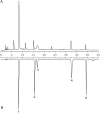Polygonum Cuspidatum Alcohol Extract Exerts Analgesic Effects via the MAPK/ERK Signaling Pathway
- PMID: 37876500
- PMCID: PMC10591627
- DOI: 10.2147/DDDT.S420002
Polygonum Cuspidatum Alcohol Extract Exerts Analgesic Effects via the MAPK/ERK Signaling Pathway
Abstract
Objective: Traditional Chinese medicine Polygonum cuspidatum (PC) has significant effects on reducing pain. In this study, we investigated the analgesic effects of the alcohol extract of PC on three types of inflammatory pain and explored its mechanism.
Methods: Potential targets for the analgesic effects of the main active components of PC alcohol extract were screened by network pharmacology and molecular docking. Three different inflammatory pain mouse models (acetic acid twisting, formalin foot swelling, and xylene ear swelling) were used to study the analgesic effects of PC. The expression of latent signaling pathways in L4-6 spinal cord tissues in formalin foot swelling mice was evaluated using real-time qPCR (RT-qPCR), Western blot (WB), and immunohistochemistry (IHC) analyses.
Results: Network pharmacology analysis shows that PC analgesic mechanism is related to the MAPK/ERK signaling pathway. The five main active components of PC have good docking ability with JNK and p38. PC alcohol extract significantly reduced the pain behavior and alleviated inflammatory reactions in three mouse models, inhibited the mRNA and protein phosphorylation levels of JNK, ERK, p38, and CREB in spinal cord tissues.
Conclusion: PC alcohol extract can inhibit inflammation and alleviate pain, which is related to its inhibition of the MAPK/ERK signaling pathway in spinal cord. Thus, PC alcohol extract is a promising candidate for pain treatment.
Keywords: MAPK/ERK; Polygonum cuspidatum; analgesic; network pharmacology.
© 2023 Lan et al.
Conflict of interest statement
The authors declare no competing of interest.
Figures







References
MeSH terms
Substances
LinkOut - more resources
Full Text Sources
Research Materials
Miscellaneous

